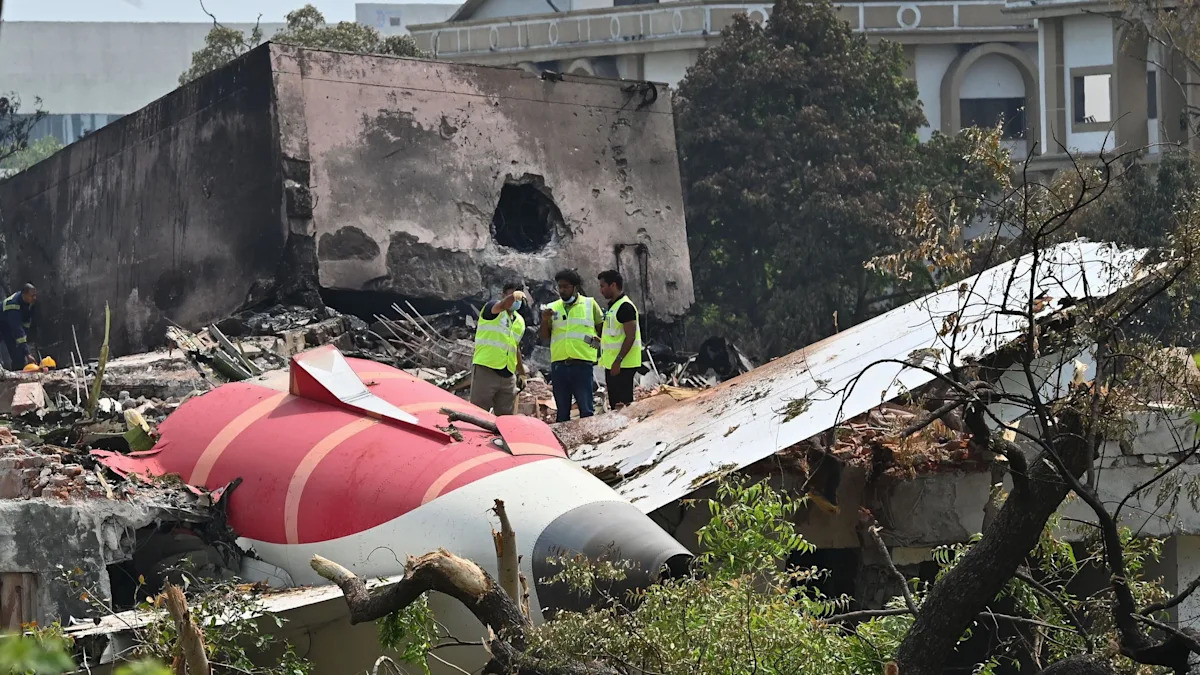Nearly five months after a plane crash in India that killed 260 people, the investigation is mired in controversy, most recently by the country's Supreme Court.
Flight 171 was heading to London from Ahmedabad in western India on June 12. It crashed into a building just 32 seconds after takeoff.
The interim report was published in July, but critics say it unfairly focused attention on the actions of the pilots, diverting attention from the possible malfunction of the plane.
On Friday, an Indian Supreme Court judge said no one could blame the plane's captain.
His comments come a week after an airline executive said there were no problems with the plane.
During a panel discussion at the Aviation India 2025 summit in New Delhi in late October, Air India chief executive Cambell Wilson admitted that the accident was “absolutely devastating for the people involved, for the families of the participants and the staff.”
However, he stressed that the initial investigation by Indian officials, summarized in the preliminary report, “found that there was nothing wrong with the aircraft, the engines or the airline's operations.”
He added that while Air India was working with investigators, it was not directly involved.
Since the accident occurred in India, the investigation is being led by the country's Aircraft Accident Investigation Bureau (AAIB). However, because the aircraft and its engines were designed and built in America, US officials are also involved.
A month after the accident, the AAIB published a report. preliminary report. This is standard procedure for investigating major accidents and is intended to provide a summary of the known facts at the time of publication.
The report is usually based on information obtained, for example, from an inspection of the crash site, as well as background material downloaded from the flight data recorder. Usually he does not make clear conclusions about the cause of the accident.
However, Air India 171's 15-page report was controversial. This has a lot to do with the content of the two short paragraphs.
First, it notes that a few seconds after takeoff, the fuel cut-off switches, typically used to start and then shut down engines before flight, were moved from the “run” position to the cut-off position.
This would starve the engines of fuel, causing a rapid loss of thrust. The switches were thrown back to restart the engines, but too late to prevent disaster.
He then says, “In the cockpit voice recording, one of the pilots can be heard asking the other why he passed out. The other pilot replied that he did not do it.”
What would the fuel switches look like in the cockpit of a Boeing 787 Dreamliner? [BBC]
This conversation, which was indirectly reported, sparked intense speculation about the role of the two pilots, Captain Sumit Sabharwal and his first officer Clive Kundera, who was flying the plane at the time.
Former National Transportation Safety Board Chairman Robert Sumwalt said the report showed “this is not a problem with the aircraft or the engines.”
“Did someone intentionally cut off the fuel supply, or was it some kind of mistake that they accidentally cut off the fuel supply?” he said during an interview with US network CBS.
Indian aviation safety consultant Captain Mohan Ranganathan, in an interview with the Indian channel NDTV, strongly suggested that the cause of the crash could have been the suicide of the pilot.
“I don't want to use that word. I heard that the pilot had some medical history and… this could happen,” he said.
Mike Andrews, a lawyer acting on behalf of the victims' families, said the way the information was disseminated “has encouraged people to unfairly and inappropriately blame these pilots without having all the information.”
“In such a complex aircraft, there are so many things that can go wrong,” he explains.
“To seize on these two very small, out-of-context pieces of information and automatically blame pilots for suicide and mass murder… is unfair and wrong.”
This view is shared by Captain Amit Singh, founder of the Safety Matters Foundation, an Indian organization that promotes a culture of safety in aviation.
He prepared a report stating that the available evidence “strongly supports the theory of electrical interference as the primary cause of engine stalling” leading to the crash.
He believes an electrical fault may have caused the Full Automatic Digital Engine Control (FADEC), a computerized system that controls engines, to initiate a shutdown, cutting off the fuel supply.
Meanwhile, in his opinion, the flight data recorder could have registered the command to cut off the fuel supply, and not any physical movement of the switches in the cockpit.
In other words, the switches themselves might not have been touched at all until the pilots tried to restart the engines.
Captain Singh also challenged the conduct of the investigation in the Supreme Court of India.
He told the BBC the preliminary report was biased because it “appears to suggest pilot error without disclosing all the technical anomalies that occurred during the flight.”
Meanwhile, the Supreme Court itself has already commented on this issue.
He is hearing a petition filed by Pushkaraj Sabharwal, father of Captain Sumit Sabharwal. The 91-year-old man is seeking an independent judicial investigation into the tragedy.
“This accident is very unfortunate, but you should not bear this burden that your son is accused of. No one can blame him for anything,” Justice Surya Kant told him.
The next hearing is expected on November 10.
“Totally wrong”
The theory that the crash could have been caused by an electrical fault is supported by the US-based Aviation Safety Foundation (FAS).
Its founder is Ed Pearson, a former Boeing senior manager who has previously been a sharp critic of the American aerospace giant's safety standards.
He believes the preliminary report was “woefully inadequate… frighteningly inadequate.”
His organization has spent time looking into reports of electrical problems on board 787 planes, including water leaks in wiring compartments that had previously been flagged by US regulator the Federal Aviation Administration. Concerns have also been raised in some other neighborhoods.
“There were so many of what we consider to be electrical oddities on this airplane that we felt it was completely wrong to identify them and actually place blame on the pilots without exhaustively analyzing and studying potential systems failures,” he says.
He believes it was a deliberate attempt to draw attention away from the plane and onto the pilots.
The FAS has called for a complete reform of current international aviation accident investigation procedures, citing “outdated protocols, conflicts of interest and systemic failures that are jeopardizing public trust and delaying vital safety improvements.”
“Keep an open mind”
Mary Schiavo, an attorney and former inspector general for the U.S. Department of Transportation, disagrees that pilots have been deliberately placed in the spotlight.
She believes the preliminary report was flawed, but only because investigators were under intense pressure to provide information and the world's attention was on them.
“I think they were just in a hurry because it was a terrible accident and the whole world was watching. They were just in a hurry to push something out,” she says.
“Then, in my opinion, the whole world jumped to conclusions and immediately said: “This is the suicide of the pilot, it was intentional.”
“If they had to do it again, I don't think they would have put in those little bits of voice recording from the booth,” she says.
In her opinion, “the most likely scenario is a computer or mechanical failure.”
International Aircraft Accident Investigation Regulations stipulate that the final report must be submitted within 12 months of the accident, but this is not always followed. However, until it is published, the true causes of the accident will remain unknown.
A former air accident investigator who spoke to the BBC stressed the importance of “keeping an open mind” until the process is complete.
Boeing has always maintained that the 787 is a safe aircraft and has a really good reputation.
The company told the BBC it would contact India's AAIB to provide information about the investigation.








